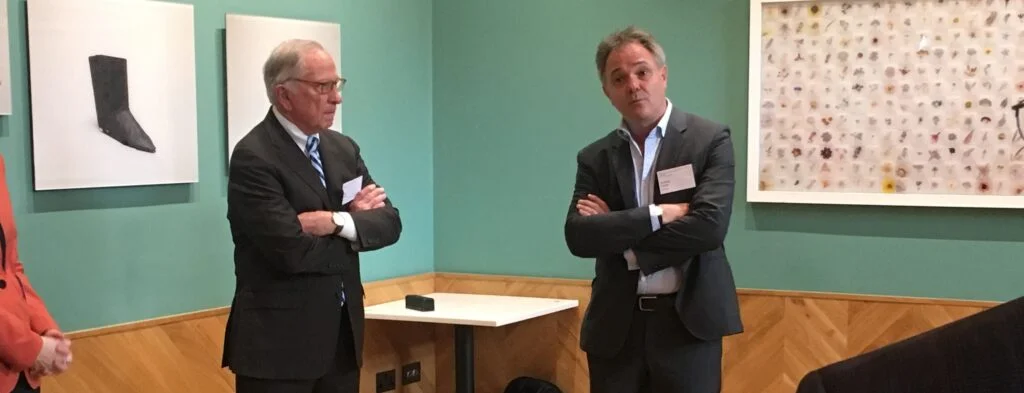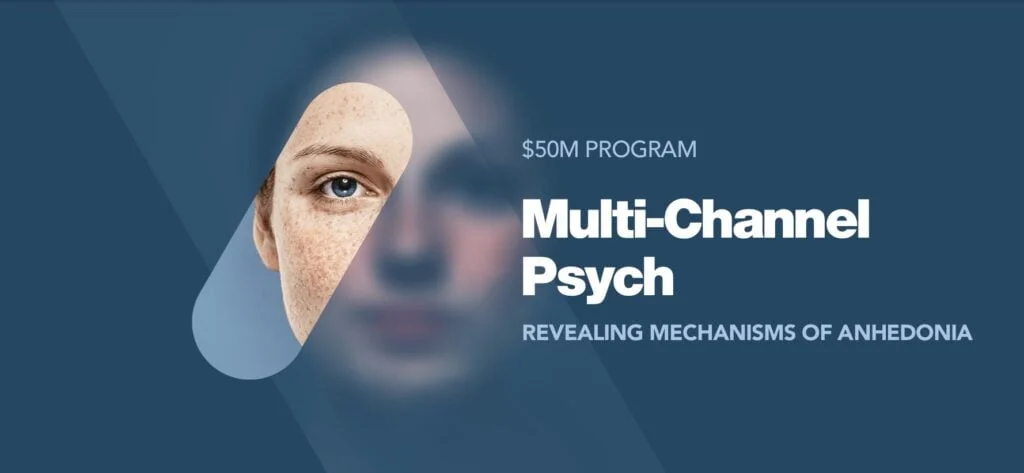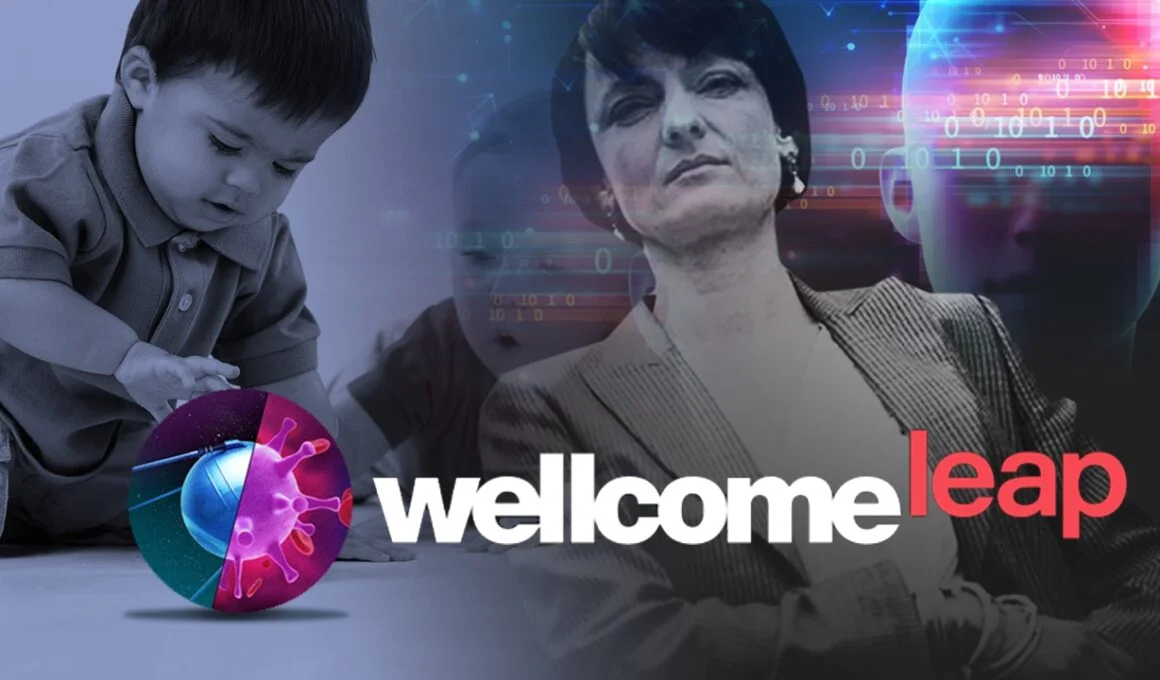A UK nonprofit with ties to global corruption throughout the COVID-19 crisis as well as historical and current ties to the UK eugenics movement launched a global health-focused DARPA equivalent last year. The move went largely unnoticed by both mainstream and independent media.
The Wellcome Trust, which has arguably been second only to Bill Gates in its ability to influence events during the COVID-19 crisis and vaccination campaign, launched its own global equivalent of the Pentagon’s secretive research agency last year, officially to combat the “most pressing health challenges of our time.” Though first conceived of in 2018, this particular Wellcome Trust initiative was spun off from the Trust last May with $300 million in initial funding. It quickly attracted two former DARPA executives, who had previously served in the upper echelons of Silicon Valley, to manage and plan its portfolio of projects.
This global health DARPA, known as Wellcome Leap, seeks to achieve “breakthrough scientific and technological solutions” by or before 2030, with a focus on “complex global health challenges.” The Wellcome Trust is open about how Wellcome Leap will apply the approaches of Silicon Valley and venture capital firms to the health and life science sector. Unsurprisingly, their three current programs are poised to develop incredibly invasive tech-focused, and in some cases overtly transhumanist, medical technologies, including a program exclusively focused on using artificial intelligence (AI), mobile sensors, and wearable brain-mapping tech for children three years old and younger.
This Unlimited Hangout investigation explores not only the four current programs of Wellcome Leap but also the people behind it. The resulting picture is of an incredibly sinister project that poses not only a great threat to current society but to the future of humanity itself. An upcoming Unlimited Hangout investigation will examine the history of the Wellcome Trust along with its role in recent and current events.
Leap’s Leadership: Merging Man and Machine for the Military and Silicon Valley

The ambitions of the Wellcome Leap are made clear by the woman chosen to lead it, former director of the Pentagon’s DARPA, Regina Dugan. Dugan began her career at DARPA in 1996; she led a counterterrorism task force in 1999 before leaving DARPA about a year later. After departing DARPA, she cofounded her own venture capital firm, Dugan Ventures, and then became special adviser to the US Army’s vice chief of staff from 2001 to 2003, which coincided with the invasions of Afghanistan and Iraq. In 2005, she created a defense-focused tech firm called RedXDefense, which contracts with the military and specifically for DARPA.
In 2009, under the Obama administration, Dugan was appointed director of DARPA by Defense Secretary Robert Gates. Much was made over her being the first female director of the agency, but she is best remembered at the agency for her so-called “Special Forces” approach to innovation. During her tenure, she created DARPA’s now defunct Transformational Convergence Technology Office, which focused on social networks, synthetic biology, and machine intelligence. Many of the themes previously managed by that office are now overseen by DARPA’s Biological Technologies Office, which was created in 2014 and focuses on everything “from programmable microbes to human-machine symbiosis.” The Biological Technologies Office, like Wellcome Leap, pursues a mix of “health-focused” biotechnology programs and transhumanist endeavors.
Right before leaving the top role at DARPA, Dugan greenlighted the agency’s initial investments in mRNA vaccine technology, which led to DARPA’s investments in Pfizer and Moderna shortly thereafter. The DARPA scientist who lobbied Dugan to back the program, Dan Wattendorf, now works as the director of Innovative Technology Solutions at the Bill & Melinda Gates Foundation.
While Dugan’s efforts at DARPA are remembered fondly by those in the national-security state, and also by those in Silicon Valley, Dugan was investigated for conflicts of interest during her time as DARPA’s director, as her firm RedXDefense acquired millions in Department of Defense contracts during her tenure. Though she had recused herself from any formal role at the company while leading DARPA, she continued to hold a significant financial stake in the company, and a military investigation later found she had violated ethics rules to a significant degree.
Instead of being held accountable in any way, Dugan went on to become a top executive at Google, where she was brought on to manage Google’s Advanced Technology and Products Group (ATAP), which it had spun out of Motorola Mobility after Google’s acquisition of that company in 2012. Google’s ATAP was modeled after DARPA and employed other ex-DARPA officials besides Dugan.
At Google, Dugan oversaw several projects, including what is now the basis of Google’s “augmented reality” business, then known as Project Tango, as well as “smart” clothing in which multitouch sensors were woven into textiles. Another project that Dugan led involved the use of a “digital tattoo” to unlock smartphones. Perhaps most controversially, Dugan was also behind the creation of a “digital authentication pill.” According to Dugan, when the pill is swallowed, “your entire body becomes your authentication token.” Dugan framed the pill and many of her other efforts at Google as working to fix “the mechanical mismatch between humans and electronics” by producing technology that merges the human body with machines to varying degrees. While serving in this capacity at Google, Dugan chaired a panel at the 2013 Clinton Global Initiative called “Game-Changers in Technology” and attended the 2015 Bilderberg meeting where AI was a main topic of discussion.
In 2016, Dugan left Google for Facebook where she was chosen to be the first head of Facebook’s own DARPA-equivalent research agency, then known as Building 8. DARPA’s ties to the origins of Facebook were discussed in a recent Unlimited Hangout report. Under Dugan, Building 8 invested heavily in brain-machine interface technology, which has since produced the company’s “neural wearable” wristbands that claim to be able to anticipate movements of the hand and fingers from brain signals alone. Facebook showcased prototypes of the project earlier this year.
Dugan left Facebook just eighteen months after joining Building 8, announcing her plans “to focus on building and leading a new endeavor,” which was apparently a reference to Wellcome Leap. Dugan later said it was as if she had been training for her role at Wellcome Leap ever since entering the workforce, framing it as the pinnacle of her career. When asked in an interview earlier this year who the clients of Wellcome Leap are, Dugan gave a long-winded answer but essentially responded that the project serves the biotech and pharmaceutical industries, international organizations such as the UN, and public-private partnerships.
In addition to her role at Wellcome, Dugan is also a member of the Council on Foreign Relations-sponsored taskforce on US Technology and Innovation policy, which was formed in 2019. Other members include LinkedIn’s Reid Hoffman, McKinsey Institute Global Chairman James Manyika, former head of Google Eric Schmidt and President Biden’s controversial top science adviser Eric Lander.
The other executive at Wellcome Leap, chief operating officer Ken Gabriel, has a background closely tied to Dugan’s. Gabriel, like Dugan, is a former program manager at DARPA, where he led the agency’s microelectromechanical systems (MEMS) research from 1992 to 1996. He served as deputy director of DARPA from 1995 to 1996 and became director of the Electronics Technology Office from 1996 to 1997, where he was reportedly responsible for about half of all federal electronics-technology investments. At DARPA, Gabriel worked closely with the FBI and the CIA.

Gabriel left DARPA for Carnegie Mellon University, where he was in charge of the Office for Security Technologies in the aftermath of September 11, 2001. That office was created after 9/11 specifically to help meet the national-security needs of the federal government, according to Carnegie Mellon’s announcement of the program. Around that same time, Gabriel became regarded as “the architect of the MEMS industry” due to his past work at DARPA and his founding of the MEMS-focused semiconductor company Akustica in 2002. He served as Akustica’s chairman and chief technology officer until 2009, at which time he returned to work at DARPA where he served as the agency’s deputy director, working directly under Regina Dugan.
In 2012, Gabriel followed Dugan to Google’s Advanced Technology and Products Group, which he was actually responsible for creating. According to Gabriel, Google cofounders Larry Page and Sergey Brin tasked Gabriel with creating “a private sector ground-up model of DARPA” out of Motorola Mobility. Regina Dugan was placed in charge, and Gabriel again served as her deputy. In 2013, Dugan and Gabriel co-wrote a piece for the Harvard Business Review about how DARPA’s “Special Forces” innovation approach could revolutionize both the public and private sectors if more widely applied. Gabriel left Google in 2014, well before Dugan, to serve as the president and CEO of Charles Stark Draper Laboratories, better known as Draper Labs, which develops “innovative technology solutions” for the national-security community, with a focus on biomedical systems, energy, and space technology. Gabriel held that position until he abruptly resigned in 2020 to co-lead Wellcome Leap with Dugan.
In addition to his role at Wellcome, Gabriel is also a World Economic Forum “technology pioneer” and on the board of directors of Galvani Bioelectronics, a joint venture of GlaxoSmithKline, which is intimately linked to the Wellcome Trust, and the Google subsidiary Verily. Galvani focuses on the development of “bioelectronic medicines” that involve “implant-based modulation of neural signals” in an overt push by the pharmaceutical industry and Silicon Valley to normalize transhumanist “medicines.” The longtime chairman of the board of Galvani, on which Gabriel serves, was Moncef Slaoui, who led the US COVID-19 vaccine development and distribution program Operation Warp Speed. Slaoui was relieved of his position at Galvani this past March over well-substantiated claims of sexual harassment.
Jeremy Farrar, Pandemic Narrative Manager
While Dugan and Gabriel ostensibly lead the outfit, Wellcome Leap is the brainchild of Jeremy Farrar and Mike Ferguson, who serve as its directors. Farrar is the director of the Wellcome Trust itself, and Ferguson is deputy chair of the Trust’s board of governors. Farrar has been director of the Wellcome Trust since 2013 and has been actively involved in critical decision making at the highest level globally since the beginning of the COVID crisis. He is also an agenda contributor to the World Economic Forum and cochaired the WEF’s Africa meeting in 2019.
Farrar’s Wellcome Trust is also a WEF strategic partner and cofounded the COVID Action Platform with the WEF. Farrar was more recently behind the creation of Wellcome’s COVID-Zero initiative, which is also tied to the WEF. Farrar has framed that initiative as “an opportunity for companies to advance the science which will eventually reduce business disruption.” Thus far it has convinced titans of finance, including Mastercard and Citadel, to invest millions in research and development at organizations favored by the Wellcome Trust.

Source: NTI.com
Some of Wellcome’s controversial medical-research projects in Africa, as well as its ties to the UK eugenics movement, were explored in a December article published at Unlimited Hangout. That report also explores the intimate connections of Wellcome to the Oxford-AstraZeneca COVID-19 vaccine, the use of which has now been restricted or banned in several countries. As mentioned in the introduction, the Wellcome Trust itself is the subject of an upcoming Unlimited Hangout investigation (Part 2).
Jeremy Farrar, who was born in Singapore in 1961, had previously been director of the Oxford University Clinical Research Unit in Ho Chi Minh City, beginning in 1998. During that time, he authored numerous epidemiological research papers. He claimed in a 2014 Financial Times article that his decision to move to Vietnam was due to his disdain for conference halls full of white men. Southeast Asia was obviously a much less regulated environment for someone in the medical-research industry wishing to indulge in groundbreaking research. Although based in Vietnam, Farrar was sent by Oxford to various locations around the globe to study epidemics happening in real time. In 2009, when swine flu was wreaking havoc in Mexico, Farrar jumped on a plane to dive right into the action, something he also did for subsequent global outbreaks of Ebola, MERS, and avian flu.
Over the past year, many questions have arisen regarding exactly how much power Farrar wields over global public health policy. Recently, the US president’s chief medical adviser, Anthony Fauci, was forced to release his emails and correspondence from March and April 2020 at the request of the Washington Post. The released emails reveal what appears to be a high-level conspiracy by some of the top medical authorities in the US to falsely claim that COVID-19 could only have been of zoonotic origin, despite indications to the contrary. The emails were heavily redacted as such emails usually are, supposedly to protect the information of the people involved, but the “(b)(6)” redactions also protect much of Jeremy Farrar’s input into these discussions. Chris Martenson, economic researcher and post-doctorate student of neurotoxicology and founder of Peak Prosperity, has had some insightful comments on the matter, including asking why such protection has been offered to Farrar given that he is the director of a “charitable trust.” Martenson went on to question why the Wellcome Trust was involved at all in these high-level discussions.
One Fauci email, dated February 25, 2020, and sent by Amelie Rioux of the WHO, stated that Jeremy Farrar’s official role at that time was “to act as the board’s focal point on the COVID-19 outbreak, to represent and advise the board on the science of the outbreak and the financing of the response.” Farrar had previously chaired the WHO’s Scientific Advisory Council. The emails also show the preparation, within a ten-day period, of the SARS-CoV-2 “‘origins” paper, which was entitled “The Proximal Origin of SARS-CoV-2” and was accepted for publication by Nature Medicine on March 17, 2020. The paper claimed that the SARS-CoV-2 virus could only have come from natural origins as opposed to gain-of-function research, a claim once held as gospel in the mainstream but which has come under considerable scrutiny in recent weeks.
Shaping the presentation of an origin story for a virus of global significance is something Farrar has been involved with before. In 2004–5, it was reported that Farrar and his Vietnamese colleague Tran Tinh Hien, the vice director at the Hospital for Tropical Diseases, were the first to identify the re-emergence of the avian flu (H5N1) in humans. Farrar has recounted the origin story on many occasions, stating: “It was a little girl. She caught it from a pet duck that had died and she’d dug up and reburied. She survived.” According to Farrar, this experience prompted him to found a global network in conjunction with the World Health Organization to “improve local responses to disease outbreaks.”
An article published by Rockefeller University Press’s Journal of Experimental Medicine in 2009 is dramatically titled, “Jeremy Farrar: When Disaster Strikes.” Farrar, when referring to the H5N1 origin story stated: “The WHO people—and this is not a criticism—decided it was unlikely that the child had SARS or avian influenza. They left, but Professor Hien stayed behind to talk with the child and her mum. The girl admitted that she had been quite sad in the previous days with the death of her pet duck. The girl and her brother had fought over burying the duck and, because of this argument, she had gone back, dug up the duck, and reburied it—probably so her brother wouldn’t know where it was buried. With that history, Professor Hien phoned me at home and said he was worried about the child. He took some swabs from the child’s nose and throat and brought them back to the hospital. That night the laboratory ran tests on the samples, and they were positive for Influenza A.”
With Farrar now having been revealed as an instrumental part of the team that crafted the official story regarding the origins of SARS-CoV-2, his previous assertions about the origin of past epidemics should be scrutinized.
As the director of a “charitable trust,” Jeremy Farrar is almost completely unaccountable for his involvement in crafting controversial narratives related to the COVID crisis. He continues to be at the forefront of the global response to COVID, in part by launching the Wellcome Leap Fund for “unconventional projects, funded at scale” as an overt attempt to create a global and “charitable” version of DARPA. Indeed, Farrar, in conceiving Wellcome Leap, has positioned himself to be just as, if not more, instrumental in building the foundation for the post-COVID era as he was in building the foundation for the COVID crisis itself. This is significant as Wellcome Leap CEO Regina Dugan has labeled COVID-19 this generation’s “Sputnik moment” that will launch a new age of “health innovation,” much like the launching of Sputnik started a global technological “space age.” Wellcome Leap fully intends to lead the pack.
“Rulers” of the Gene-Sequencing Industry
In contrast to the overt DARPA, Silicon Valley, and Wellcome connections of the others, the chairman of the board of directors of Wellcome Leap, Jay Flatley, has a different background. Flatley is the long-time head of Illumina, a California-based gene-sequencing hardware and software giant that is believed to currently dominate the field of genomics. Though he stepped down from the board of Illumina in 2016, he has continued to serve as the executive chairman of its board of directors. Flatley was the first to be chosen for a leadership position at Wellcome Leap, and he was responsible for suggesting Regina Dugan for the organization’s chief executive officer, according to a recent interview given by Dugan.

As a profile on Illumina in the business magazine Fast Company notes, Illumina “operates behind the scenes, selling hardware and services to companies and research institutions,” among them 23andMe. 23andMe’s CEO, Anne Wojcicki, the sister of YouTube CEO Susan Wojcicki and the wife of Google cofounder Sergey Brin, told Fast Company, “It’s crazy. Illumina is like the ruler of this whole universe and no one knows that.” The report notes that 23andMe, like most companies that offer DNA sequencing and analysis to consumers, uses machines produced by Illumina.
In 2016, Illumina launched an “aggressive” five-year plan to “bring genomics out of research labs and into doctors’ offices.” Given the current state of things, particularly the global push toward gene-focused vaccines and therapies, that plan, which concludes this year, could not have been any better timed. Illumina’s current CEO, Francis DeSouza, previously held key posts at Microsoft and Symantec. Also in 2016, Illumina’s executive teams forecast a future in which humans are gene tested from birth to grave for both health and commercial purposes.
Whereas most companies have struggled financially during the coronavirus pandemic, some have seen a massive increase in profits. Illumina has witnessed its share price double since the start of the COVID crisis. The company’s $1 billion plus in profits during the last tax year was obviously helped by the quick approval of the NovaSEQ 6000 machines, which can test a large number of COVID samples more quickly than other devices. An individual machine has a hefty price tag of almost $1 million, and thus they are mostly found at elite facilities, private labs, and top-tier universities.

In addition to his long-standing leadership role at Illumina, Jay Flatley is also a “digital member” of the World Economic Forum as well as the lead independent director of Zymergen, a WEF “tech pioneer” company that is “rethinking biology and reimagining the world.” Flatley, who has also attended several Davos meetings, has addressed the WEF on the “promise of precision [i.e., gene-specific] medicine.” At another WEF panel meeting, Flatley, alongside UK Health Secretary Matt Hancock, promoted the idea of making genomic sequencing of babies at birth the norm, claiming it had “the potential to shift the healthcare system from reactive to preventative.” Some at the panel called for the genomic sequencing of infants to eventually become mandatory.
Aside from Flatley as an individual, Illumina as a company is a WEF partner and plays a key role in its platform regarding the future of health care. A top Illumina executive also serves on the WEF’s Global Future Council on Biotechnology.
A New HOPE
Wellcome Leap currently has four programs: Multi-Stage Psych, Delta Tissue, 1KD, and HOPE. HOPE was the first program to be announced by Wellcome Leap and stands for Human Organs, Physiology and Engineering. According to the full program description, HOPE aims “to leverage the power of bioengineering to advance stem cells, organoids, and whole organ systems and connections that recapitulate human physiology in vitro and restore vital functions in vivo.”

HOPE consists of two main program goals. First, it seeks to “bioengineer a multiorgan platform that recreates human immunological responses with sufficient fidelity to double the predictive value of a preclinical trial with respect to efficacy, toxicity and immunogenicity for therapeutic interventions.” In other words, this bioengineered platform mimicking human organs would be used to test the effects of pharmaceutical products, including vaccines, which could create a situation in which animal trials are replaced with trials on gene-edited and farmed organs. Though such an advance would certainly be helpful in the sense of reducing often unethical animal experimentation, trusting such a novel system to allow medical treatments to go straight to the human-testing phase would also require trusting the institutions developing that system and its funders.
As it stands now, the Wellcome Trust has too many ties to corrupt actors in the pharmaceutical industry, having originally begun as the “philanthropic” arm of UK drug giant GlaxoSmithKline, for anyone to trust what they are producing without actual independent confirmation, given the histories of some of their partners in fudging both animal and human clinical trial data for vaccines and other products.
The second goal of HOPE is to open up the use of machine-human hybrid organs for transplantation into human beings. That goal focuses on restoring “organ functions using cultivated organs or biological/synthetic hybrid systems” with the later goal of bioengineering a fully transplantable human organ after several years.
Later on in the program description, however, the interest in merging the synthetic and biological becomes clearer when it states: “The time is right to foster synergies between organoids, bioengineering and immunoengineering technologies, and advance the state-of-the-art of in vitro human biology . . . by building controllable, accessible and scalable systems.” The program description document also notes the interest of Wellcome in genetic-engineering approaches for the “enhancement of desired properties and insertion of traceable markers” and Wellcome’s ambition to reproduce the building blocks of the human immune system and human organ systems through technological means.
Transhumanist Toddlers?
The second program to be pursued by Wellcome Leap is called “The First 1000 Days: Promoting Healthy Brain Networks,” which is abbreviated as 1KD by the organization. It is arguably the most unsettling program because it seeks to use young children, specifically infants from three months to three-year-old toddlers, as its test subjects. The program is being overseen by Holly Baines, who previously served as strategy development lead for the Wellcome Trust before joining Wellcome Leap as the 1KD program leader.

1KD is focused on developing “objective, scalable ways to assess a child’s cognitive health” by monitoring the brain development and function of infants and toddlers, allowing practitioners to “risk-stratify children” and “predict responses to interventions” in developing brains.
The program description document notes that, up to this point in history, “our primary window into the developing brain has been neuroimaging techniques and animal models, which can help identify quantitative biomarkers of [neural] network health and characterise network differences underlying behaviours.” It then states that advances in technology “are opening additional possibilities in young infants.”
The program description goes on to say that artificial neural networks, a form of AI, “have demonstrated the viability of modelling network pruning process and the acquisition of complex behaviours in much the same way as a developing brain,” while improvements in machine learning, another subset of AI, can now be used to extract “meaningful signals” from the brains of infants and young children. These algorithms can then be used to develop “interventions” for young children deemed by other algorithms to be in danger of having underdeveloped brain function.
The document goes on to note the promise of “low-cost mobile sensors, wearables and home-based systems” in “providing a new opportunity to assess the influence and dependency of brain development on natural physical and social interactions.” In other words, this program seeks to use “continuous visual and audio recordings in the home” as well as wearable devices on children to collect millions upon millions of data points. Wellcome Leap describes these wearables as “relatively unobtrusive, scalable electronic badges that collect visual, auditory and motion data as well as interactive features (such as turn-taking, pacing and reaction times).” Elsewhere in the document there is a call to develop “wearable sensors that assess physiological measures predictive of brain health (e.g., electrodermal activity, respiratory rate, and heart rate) and wireless wearable EEG or eye-tracking technology” for use in infants and children three and under.
Like other Wellcome Leap programs, this technology is being developed with the intention of making it mainstream in medical science within the next five to ten years, meaning that this system—although framed as a way to monitor children’s brain functioning to improve cognitive outcomes—is a recipe for total surveillance of babies and very young children as well as a means for altering their brain functioning as algorithms and Leap’s programmers see fit.
1DK has two main program goals. The first is to “develop a fully integrated model and quantitive measurement tools of network development in the first 1000 days [of life], sufficient to predict EF [executive function] formation before a child’s first birthday.” Such a model, the description reads, “should predict contributions of nutrition, the microbiome and the genome” on brain formation as well as the effects of “sensimotor and social interactions [or lack thereof] on network pruning processes” and EF outcomes. The second goal makes it clear that widespread adoption of such neurological-monitoring technologies in young children and infants is the endgame for 1DK. It states that the program plans to “create scalable methods for optimising promotion, prevention, screening and therapeutic interventions to improve EF by at least 20% in 80% of children before age 3.”
True to the eugenicist ties of the Wellcome Trust (to be explored more in-depth in Part 2), Wellcome Leap’s 1DK notes that “of interest are improvements from underdeveloped EF to normative or from normative to well-developed EF across the population to deliver the broadest impact.” One of the goals of 1DK is thus not treating disease or addressing a “global health public challenge” but instead experimenting on the cognitive augmentation of children using means developed by AI algorithms and invasive surveillance-based technology.
Another unsettling aspect of the program is its plan to “develop an in vitro 3D brain assembloid that replicates the time formation” of a developing brain that is akin to the models developed by monitoring the brain development of infants and children. Later on, the program description calls this an “in-silico” model of a child’s brain, something of obvious interest to transhumanists who see such a development as a harbinger of the so-called singularity. Beyond that, it appears that this in-silico and thus synthetic model of the brain is planned to be used as the “model” to which infant and children brains are shaped by the “therapeutic interventions” mentioned elsewhere in the program description.
It should be clear how sinister it is that an organization that brings together the worst “mad scientist” impulses of both the NGO and military-research worlds is openly planning to conduct such experiments on the brains of babies and toddlers, viewing them as datasets and their brains as something to be “pruned” by machine “intelligence.” Allowing such a program to advance unimpeded without pushback from the public would mean permitting a dangerous agenda targeting society’s youngest and most vulnerable members to potentially advance to a point where it is difficult to stop.
A “Tissue Time Machine”
The third and second-most recent program to join the Wellcome Leap lineup is called Delta Tissue, abbreviated by the organization as ΔT. Delta Tissue aims to create a platform that monitors changes in human-tissue function and interactions in real time, ostensibly to “explain the status of a disease in each person and better predict how that disease would progress.” Referring to this platform as a “tissue time machine,” Wellcome Leap sees Delta Tissue as being able to predict the onset of disease before it occurs while also allowing for medical interventions that “are targeted to the individual.”

Well before the COVID era, precision medicine or medicine “targeted or tailored to the individual” has been a code phrase for treatments based on patients’ genetic data and/or for treatments that alter nucleic acid (e.g., DNA and RNA) function itself. For instance, the US government defines “precision medicine” as “an emerging approach for disease treatment and prevention that takes into account individual variability in genes, environment, and lifestyle for each person.” Similarly, a 2018 paper published in Technology notes that, in oncology, “precision and personalized medicine . . . fosters the development of specialized treatments for each specific subtype of cancer, based on the measurement and manipulation of key patient genetic and omic data (transcriptomics, metabolomics, proteomics, etc.).”
Prior to COVID-19 and the vaccine roll outs, the mRNA vaccine technology used by the DARPA-funded companies Moderna and Pfizer were marketed as being precision medicine treatments and were largely referred to as “gene therapies” in media reports. They were also promoted heavily as a revolutionary method of treating cancer, making it unsurprising that the Delta Tissue program at Wellcome Leap would use a similar justification to develop a program that aims to offer tailored gene therapies to people before the onset of a disease.
This Delta Tissue platform works to combine “the latest cell and tissue profiling technologies with recent advances in machine learning,” that is, AI. Given Wellcome Leap’s connections to the US military, it is worth noting that the Pentagon and Google, both former employers of Wellcome Leap CEO Regina Dugan and COO Ken Gabriel, have been working together since last September on using AI to predict disease in humans, first focusing on cancer before expanding to COVID-19 and every disease in between. The Delta Tissue program appears to have related ambitions, as its program description makes clear that the program ultimately aims to use its platform for a host of cancers and infectious diseases.
The ultimate goal of this Wellcome Leap program is “to eradicate the stubbornly challenging diseases that cause so much suffering around the world.” It plans to do this through AI algorithms, however, which are never 100 percent accurate in their predictive ability, and with gene-editing treatments, nearly all of which are novel and have not been well tested. That latter point is important given that one of the main methods for gene-editing in humans, CRISPR, has been found in numerous studies to cause considerable damage to the DNA, damage that is largely irreparable (see here, here and here). It seems plausible that a person placed on such a hi-tech medical treatment path will continue to need a never-ending series of gene-editing treatments and perhaps other invasive hi-tech treatments to mitigate and manage the effects of clumsy gene splicing.
Total Surveillance to Treat “Depression”
Wellcome Leap’s most recent program, launched just this week, is called “Multi-Channel Psych: Revealing Mechanisms of Anhedonia” and is officially focused on creating “complex, biological” treatments for depression.

Those behind Wellcome Leap frame the problem they aim to tackle with this program as follows:
“We understand that synaptic connections serve as the currency of neural communication, and that strengthening or weakening these connections can facilitate learning new behavioral strategies and ways of looking at the world. Through studies in both animal models and humans, we have discovered that emotional states are encoded in complex neural network activity patterns, and that directly changing these patterns via brain stimulation can shift mood. We also know that disruption of these delicately balanced networks can lead to neuropsychiatric illness.” (emphasis added)
They add that “biologically based treatments” for depression “are not being matched to the biology of the human beings they’re being used in,” and, thus, treatments for depression need to be tailored “to the specific biology” of individual patients. They clearly state that what needs to be addressed in order to make such personal modifications to treatment is to gain “easy access to the biological substrate of depression—i.e. the brain.”
Wellcome Leap’s program description notes that this effort will focus specifically on anhedonia, which it defines as “an impairment in the effort-based reward system” and as a “key symptom of depression and other neuropsychiatric illnesses.” Notably, in the fine print of the document, Wellcome Leap states:
“While there are many definitions of anhedonia, we are less interested in the investigation of reduced consummatory pleasure, the general experience of pleasure, or the inability to experience pleasure. Rather, as per the description above, we will prioritize investigations of anhedonia as it relates to impairments in the effort-based reward system—e.g. reduced motivation to complete tasks and decreased capacity to apply effort to achieve a goal.”
In other words, Wellcome Leap is only interested in treating aspects of depression that interfere with an individual’s ability to work, not in improving an individual’s quality or enjoyment of life.
Leap notes, in discussing its goals, that it seeks to develop models for how patients respond to treatments that include “novel or existing behavior modification, psychotherapy, medication, and neurostimulation options” while also capturing an individual’s “genome, phenome [the sum of an individual’s phenotypic traits], [neural] network connectivity, metabolome [the sum of an individual’s metabolic traits], microbiome, reward processing plasticity levels,” among others. It ultimately aims to predict the relationship between an individual’s genome to how “reward processing” functions in the brain. It implies that the data used to create this model should involve the use of wearables, stating that researchers “should seek to leverage high frequency patient-worn or in-home measurements in addition to those obtained in the clinic, hospital or laboratory.”
One of the main research areas included in the program looks to “develop new scalable measurement tools for reliable and high-density quantification of mood (both subjectively reported and objectively quantified via biometrics such as voice, facial expression, etc.), sleep, movement, reward system functioning, effort/motivation/energy levels, social interaction, caloric intake, and HPA axis output in real-world situations.” The HPA (hypothalamic-pituitary-adrenal) axis is mentioned throughout the document, and this is significant as it is both a negative and positive feedback system regulating the mechanisms of stress reactions, immunity, and also fertility in the human body. The latter is especially important given the Wellcome Trust’s ties to the UK eugenics movement. It is also worth noting that some commercially available wearables, such as Amazon’s Halo, already quantify mood, sleep, and movement.
The program’s authors go even further than the above in terms of what they wish to monitor in real time, stating, “We specifically encourage the development of non-invasive technology to directly interrogate human brain state.” Examples include “a non-invasive spinal tap equivalent,” “behavioral or biomarker probes of neural plasticity,” and “single-session neural monitoring capabilities that define a treatment-predictive brain state.”
In other words, this Wellcome Leap program and its authors seek to develop “non-invasive” and, likely, wearable technology capable of monitoring an individual’s mood, facial expressions, social interactions, effort and motivation, and potentially even thoughts in order to “directly interrogate human brain state.” To think that such a device would stay only in the realm of research is naive, especially given that WEF luminaries have openly spoken at Davos meetings about how governments plan to use such technology widely on their populations as a means of pre-emptively targeting would-be dissent and ushering in an era of “digital dictatorships.”
The focus on treating only the aspects of depression that interfere with a person’s work further suggests that such technology, once developed, would be used to ensure “perfect worker” behavior in industries where human workers are rapidly being replaced with AI and machines, meaning the rulers can be more selective about which people continue to be employed and which do not. Like other Wellcome Leap programs, if completed, the fruits of the Multi-Channel Psych program will likely be used to ensure a population of docile automatons whose movements and thoughts are heavily surveilled and monitored.
The Last Leap for an Old Agenda
Wellcome Leap is no small endeavor, and its directors have the funding, influence, and connections to make their dreams reality. The organization’s leadership includes the key force behind Silicon Valley’s push to commercialize transhumanist tech (Regina Dugan), the “architect” of the MEMS industry (Ken Gabriel), and the “ruler” of the burgeoning genetic-sequencing industry (Jay Flatley). It also benefits from the funding of the world’s largest medical-research foundation, the Wellcome Trust, which is also one of the leading forces in shaping genetics and biotechnology research as well as health policy globally.
A 1994 Sunday Times investigation into the Trust noted that “through [Wellcome Trust] grants and sponsorships, government agencies, universities, hospitals and scientists are influenced all over the world. The trust distributes more money to institutions than even the British government’s Medical Research Council.”
It then notes:
“In offices on the building’s first floor, decisions are reached that affect lives and health on scales comparable with minor wars. In the conference room, high above the street, and in the meeting hall, in the basement, rulings in biotechnology and genetics are handed down that will help shape the human race.”
Little has changed regarding the Trust’s influence since that article was published. If anything, its influence on research paths and decisions that will “shape the human race” has only grown. Its ex-DARPA officials, who have spent their careers advancing transhumanist technology in both the public and private sectors, have overlapping goals with those off Wellcome Leap. Dugan’s and Gabriel’s commercial projects in Silicon Valley reveal that Leap is led by those who have long sought to advance the same technology for profit and for surveillance. This drastically weakens Wellcome Leap’s claim to now be pursuing such technologies to only improve “global health.”

Indeed, as this report has shown, most of these technologies would usher in a deeply disturbing era of mass surveillance over both the external and internal activities of human beings, including young children and infants, while also creating a new era of medicine based largely on gene-editing therapies, the risks of which are considerable and also consistently downplayed by its promoters.
When one understands the intimate bond that has long existed between eugenics and transhumanism, Wellcome Leap and its ambitions make perfect sense. In a recent article written by John Klyczek for Unlimited Hangout, it was noted that the first director general of UNESCO and former president of the UK Eugenics Society was Julian Huxley, who coined the term “transhumanism” in his 1957 book New Bottles for New Wine. As Klyczek wrote, Huxley argued that “the eugenic goals of biologically engineering human evolution should be refined through transhumanist technologies, which combine the eugenic methods of genetic engineering with neurotech that merges humans and machines into a new organism.”
Earlier, in 1946, Huxley noted in his vision for UNESCO that it was essential that “the eugenic problem is examined with the greatest care and that the public mind is informed of the issues at stake so that much that is now unthinkable may at least become thinkable,” an astounding statement to make so soon after the end of World War II. Thanks in large part to the Wellcome Trust and its influence on both policy and medical research over the course of several decades, Huxley’s dream of rehabilitating eugenics-infused science in the post–World War II era could soon become reality. Unsurprisingly, the Wellcome Trust hosts the archive of the formerly Huxley-led Eugenics Society and still boasts close ties to its successor organization, the Galton Institute.
The over-riding question is: Will we allow ourselves to continue to be manipulated into allowing transhumanism and eugenics to be openly pursued and normalized, including through initiatives like those of Wellcome Leap that seek to use babies and toddlers as test subjects to advance their nightmarish vision for humanity? If well-crafted advertising slogans and media campaigns painting visions of utopia such as “a world without disease” are all that is needed to convince us to give up our future and our children’s future to military operatives, corporate executives, and eugenicists, then there is little left of our humanity to surrender.
Author’s note: Johnny Vedmore contributed to this report.
Featured photo: Antonio Cabrera for Unlimited Hangout











Never mind “non-invasives”. Current nanotechnology permits injectable biodigital tools that can compute, communicate, edit, influence and control genomic and neural activity. Humanity needs to wake up, and fast! Thank you for your fine, persistent and accurate research, and efforts to wake and inform the public.
Re “Humanity needs to wake up, and fast!”
Most of humanity has been asleep for eons. On what grounds would they now wake up, never mind “fast”? Read “The 2 Married Pink Elephants In The Historical Room –The Holocaustal Covid-19 Coronavirus Madness: A Sociological Perspective & Historical Assessment Of The Covid “Phenomenon”” by Rolf Hefti at https://www.rolf-hefti.com/covid-19-coronavirus.html
hey w
Witney thanks for this great article. are you framiliar with Rudolf
Steiners work at all? He talks about the rise of Ahriman coming to an apex in the 21 st century. This whole business you have descibed in the article above is described perfectly in a 2 1/2 hr youtube reading call The Incarnation of Ahriman in a Physical Body. It’s very chilling, especially the last 7 mins, if you don’t have the time or interest in the whole lecture?
if you look more closely, you will find ties between the occult and the transhumanist agenda. Barbara Marx Hubbard is a household name in that regard (died in 2019, I believe). However, I would recommend looking at the “real thing” rather than a side branch like Steiner, whose main trunk is that of Theosophy. Yes, they want to introduce their messiah into the world, and prepare the marriage between the human and the superhuman. Invoking demonic posession is a practice in many occult religions
Truly mind blowing. It does seem as though they plan to completely augment humans into cyBorgs.
They will knock off the 95% (useless eaters) and create a new race of transhumans under their complete control using the genetically selected and augmented children.
Watching for your next installment and thanks to you Whitney and Johnny.
Yet another example of the “you couldn’t make this stuff up” realm of surreal oligarchic planning for the collective future of we mere mortals who are simply too insignificant to be consulted about any of this. That anyone would trust these organizational forces and individuals is rather mind boggling in itself. So let me see if I have this right – the same global oligarchy that doesn’t care if you’re homeless and living under a freeway overpass, if you’re without food, without healthcare, without a job and without a future – somehow simultaneously deeply cares about your “health” and whether you might get a “disease” and so can’t wait to experiment on your kids?
And still, they have no cure for the common cold. These would-be ‘controllers of the world’ are lost in their own over-expanded egos, illusions and dreams. Nature’s laws cannot be broken, bent or transhumanised – as they will find out as their grand plans inevitably fail.
Yes. The mostly ageing global megalomaniacs are desperate for their ‘swan song’ and to leave their satanic and nutty legacies for future generations. Like King Canute, they will not be able to turn back the tide.
These maniacs are all severely mentally ill, and know absolutely nothing about leadership.
In fact the very worst sort of people to be allowed this unchecked power.
But then defective and manipulable humans have consented to and permit all this.
Too late now. Enjoy the ride folks, you who are parents sold out your own children.
Oh not so fast….MODERNA has announced a new vaccine for the common cold. I will pass on that vaccine as well.
And is desperate to keep your granny and grandpa safe to the extent of forcing them into isolation from family and friends and forcing them to have experimental injections. As well as banning friends and family from their funeral. All to keep everyone ‘safe’ from a ‘pandemic’.
This goes right along with the WEF’s 8 predictions for 2030, including using 3D printers for organ transplants after they’ve grown the desired gene sequenced prototype. This will ensure the creation of automated bots capable of productivity maximization is easily achieved for these sweatshop globalist types. It also coincides with the globalist’s idea that society represents little more than their “hackable animals.” This kind of disclosure better help the collective shake off a century old deep slumber state while we still possess free will. Thank you Whitney and Johnny for shining a light on this topic.
Great work exposing the evil. If a misappropriation of funds , embezzlement , tax evasion or any criminal activity to stop these soulless cold blooded evil lowlifes it would benefit humanity.
Thank you for such an evidence-based report. Will share without hesitation.
One point stood out to me at the end. All right, we are preparing these people for work and this might require a little brain manipulation but it may be the job or lack of it or the financial stress or any number of social crises that caused the person’s stress. When there are enough people facing these stresses, we have a system problem. You don’t solve a system problem at the individual level. You change the system and that is what our media always shies away from. A Western Australian doctor / politician recently wrote a book called: Overprescribing Madness that made the same point. https://booko.com.au/search?query_type=1&q=overprescring+madness
On a less technical level, you might look at the Chair of Wellcome Trust, Julia Gillard. While Julia is sainted as a great defender of women’s rights many remember her differently. You are great researcher. I will give you brief precis here but if you want more detail, I can help with it. She pushed single parents (mainly women) onto a lower unemployment pension from a single parent one causing huge distress. She cemented the Howard destruction of unions through her Fair Work Act as Unemployment Minister. Australians now are pushed into narrow enterprise bargaining and you have to ask permission from this body to strike. She caved in to mining companies which was the one of the reasons she was chosen to displace Kevin Rudd. The other reason was Rudd’s seeking a bipartisan approach to US / China relations. Her best work was as Education Minister. She brought Joel Klein to Australia to promote charter schools. This was funded by UBS finance. She brought micro-testing for primary and early high school. She destroyed out TAFE system (the equivalent of your community colleges). She sought to take away Julian Assange’s citizenship (stated by Wikileaks and John Pilger). And how has she been rewarded for this? She is Brookings Institute’s ‘Education Champion’. She is the head of the Global Partnership for Education (Gates recently connected with this organisation) and also the Wellcome Trust.
I read that Julia’s first action upon being selected as P.M. was to meet with the mining lobby to grant them their demands – in return for making her P.M. I was also sickened with her obvious crawling adoration of the vile Obama when he visited Australia. She is one of “them”.
Thanks for this information Warren.
As a fellow Australian, I endorse your comments, Warren. I understand that space constraints restricted your ability to detail Gillard’s not-so-auspicious or above-board career in the legal profession. She seems to have attached her post-Australian political career to the coat-tails of Hillary Clinton, which any Aussie sheep-shagger would know is an appropriate place for Gillard to “hang out”.
Great research. Thank you Whitney.
I seems you guys just like regular comments!
“It’s crazy. Illumina is like the ruler of this whole universe and no one knows that.”
In 2016-2017, selling very high speed storage, I personally complained to the CIA and State Dept in writing and by phone (CIA rep told me tell State Dept instead) that Illumina’s insistence in driving all US and European researchers into the cloud to run their software solutions to analyze their sequencers DNA and RNA sequence output took approx 24 hours per sequence, as opposed to the Chinese buying fastest storage hardware only and running everything in house, no cloud, doing what Illumina was doing over 24 hours just to make a lot of money in cloud software and services, the Chinese did every 20 minutes: 72X faster than us per day in every aspect of genetic research. One day in China’s labs takes 72 here.
I thought Illumina was just greedy as fuck. Now, it seems it’s to intentionally slow down public research. Behind the scenes, it’s no doubt all fast on-premises gear, no clouds allowed.
Clouds are inherently insecure. There will be announcements of Chinese hacking into our research clouds and such. It will be cover. Real for business, but that’s not all that’s going on.
It doesn’t matter when all of this virus and cancer research is in the realm of imagination.
Read the book virus mania and see how much pharma made up diseases and pandemics to cover up for the real causes of diseases.
Example: pesticides like ddt caused polio. Cancer caused by ground water toxins like atrazine.
What’s the point of genetic research if most disease comes from toxins and nutritional deficiencies?
To make a reason to modify people to push for eugenics and zombies.
This explains why Gates et al are obsessed with pushing the deadly infectious disease model. It’s essentially a cover for the environmental assaults and toxins released by the military-medical cartel. These will accelerate dramatically unless this whole scam is exposed as a crime against humanity.
Will someone please pinch me and wake me from this never-ending nightmare???
i have no doubt these ghouls have said and done all these evil things. some may even believe what they have been selling. why not? it has brought them enormous power and gobs of $$$$. but i know that what they are selling (a new transhumanist organism????? hahahaha!!!) is a complete snake oil. but they will continue to sell it as long as there’s a buyer who finds it useful to fearmonger, rule, and exploit people. thank you Whitney for another report full of real names and their specific crimes against humanity.
Whitney Webb is a journalistic superhero.
Keep picking that scab that is sir Jeremy
Stinking of Rockefeller university
Sars 1
Bali bombing
Mekong basin disease surveillance
Rat g Rox
Seqoia bank ( scariest website ever )
Black rock
This guy is a top lifelong spook who has pushed the boat out way too far . Finish him WW
“First, it seeks to “bioengineer a multiorgan platform that recreates human immunological responses with sufficient fidelity to double the predictive value of a preclinical trial with respect to efficacy, toxicity and immunogenicity for therapeutic interventions.” … Though such an advance would certainly be helpful in the sense of reducing often unethical animal experimentation, trusting such a novel system to allow medical treatments to go straight to the human-testing phase would also require trusting the institutions developing that system and its funders.”
It’s not science. It’s hubris. They erred right at the start, thinking that they could ‘not’ look at the patient that they would have us say they care about. Of course, Look at who they are. This isn’t about our welfare. Dawn Lester and David Parker look at how far the professional scam artists within the Rockefeller health care system have gone from anything resembling reasonable practices:
“The manufacture of medicines involves a number of different stages, the first of which may include the isolation of the active ingredient of a plant claimed to have curative properties and its synthesis into a chemical compound… Some pharmaceutical companies report that they no longer use diseased tissue for this type of testing and that instead, they now use ‘disease molecules’, which can be molecules of genetic material, either DNA or RNA, or protein molecules… However, the idea the effects produced by chemical compounds may have a beneficial effect in a living human being is totally inappropriate for a number of reasons. One of the main reasons is that, when tested, disease molecules are no longer in their natural environment with the human body…”
Let alone the fact that the above lunatics go further, and further from any sort of sound research, than just using ‘disease molecules’. They are the disease we must cure ourselves of, which we’ll need help with.
“One of the goals of 1DK is thus not treating disease or addressing a “global health public challenge” but instead experimenting on the cognitive augmentation of children using means developed by AI algorithms and invasive surveillance-based technology.” As if God can’t heal us. As if God didn’t plan to raise us (who are loyal and who remain after Armageddon and who experience resurrection after Armageddon, around the corner, is ended) to the perfection that accords with his design for a human being. Those playing God can’t do that, let alone surpass God’s work. But they can make it clear that they are faithless and have no use for the true God, whose name is Jehovah (meaning He Causes To Become).
I finally got to the end of this deep dive. Wow! That was clearly a lot of work. Well done authors. It’s scary stuff, but I would rather know than not. I’ll be using the info in my next blog post.
I have great admiration for a young person like Whitney Webb that does very important reporting not just once but repeatedly.
But I am at the same time saddened by the reality that most in the West don’t know and don’t care what their corrupt elites are evolving their world into while padding their back accounts. I grieve for the world my children will live in past my time. My hope is that enough young that wake up to march against the technocratic button pushing elites using all manner of strategy to neutralize the vermin and their agenda.
Thanks Whitney, as always – not everything is Bill Gates.
I think the phrase to hang on to in all this is their perceived need to ‘to fix “the mechanical mismatch between humans and electronics”’. Yes there is a mismatch, thank goodness, despite the fact that we are also electric beings, but it is an electricity they really have no concept of, even if they can measure it. They are trying to graft digital tech onto our analogue selves, who have on top indefinable spirit which they hardly recognise existing much less understand.
The question here is not if they’ll succeed (they won’t) but how many lives they’ll kill or ruin in the process.
An interesting article. And they are researching a lot of different machine/brain interfaces administered by a syringe. This is the published research and one can only speculate on the unpublished dito at places like DARPA.
I will continue to work on my own shortcomings the old fashion way and politely decline any “upgrade”.
What is to me most striking about all these things is we have a number of factions which are competing to impose variety of science fiction dystopias upon us. But the dytopia most likely to actually come to fruition is the unplanned one. Which will probably involve a big trainwreck of all the others across the weakened trestle of bad management, untrammelled greed, general mendacity and bottomless treachery. Poetic enough for you?
The Queen of Mean. Regina was touting digital skin tattoos way back in 2013. History doesn’t repeat but it rhymes
https://www.youtube.com/watch?v=fzB1EcocAF8
I always look forward to your amazing research!
Thank You
I am very grateful to Whitney Webb and Johnny Vedmore for this research into Wellcome Leap, and the ongoing story of the Eugenics agenda and the Galton Lab. I am a survivor of the eugenics and mind control projects, and have recently come forward to share my story on several platforms. However this information helps fill in technical information that I have never been able to wade through the ‘discovery research’ to find myself. I mostly have to do my own internal work to heal from the decades of trauma. I am the only child of two parents who met as PhD candidates at the Galton Laboratory for Eugenics in London, England, as it was called in 1965, when they were both there. My mother, Moyra Smith MD PhD, began her PhD study at the Galton under Lionel Penrose and eventually Harry Harris, his successor, who became her primary mentor. Later, when Harris went to University of Pennsylvania to bring the modern eugenics movement to the United States, David Hopkinson succeeded him as Director of the Galton, and he was there when I would be taken to the Galton ‘for use’ in the years 1984 to about 1992. These were not just some creepy eugenicist scientists ‘out there’. They were family friends, they came to visit us on holiday, and of course there were the many trips taken to see them, for me, this meant being carted all over the world to genetics conferences, the WHO conference in Paris 1989, to the Galton Lab (and probably Tavistock) many times, being ‘worked’ consistently in the labs at NIH in Washington D.C. for a year and then off and on afterwards, being held in locked confinement in the genetics labs at Los Alamos in New Mexico, the list is extensive. Its thousands of trauma scenes. And I have to clear them one by one to dig my way out into some kind of wholeness in my adult life. When my mother had to be away on a trip to the Galton, on one occasion the secretary of the Galton Lab, Jean Barry, was sent to our home in California to care for me. This was no ‘ordinary scientific ‘family’. This was cult. This was scientific mafia.
And then, there was the Wellcome piece. That bit was only ever a ‘single’ snippet of childhood memory from about 1986 and a hideous visit to their museum. But in roughly 2017 I knew my mother was working in their library and archives extensively, handling ancient manuscripts related to genetics occult practices of some sort for her own work. I still remember her glee at being ‘so honored’ and excited to be working with the Wellcome Trust and their ‘collection’.
Anyway, its just all a nightmare. I felt it important to comment here, despite the risk, and the naming names, because I know there might be some people who may wonder ‘well how bad could it really be?’ Its bad, its really bad. If you are interested in hearing about these groups and the aftermath of their ‘science’ and being forced to endure it for decades on end from a personal stance of a survivor’s account, and the formal whistleblowing efforts I have made (a total flop) to some of the institutions involved, please see my interview on Macroaggressions with Charlie Robinson (episode #495), or my interview with Richard Willett on his show Classified on Ickonic, Series 4, episode 19, released in October 2024. There is a full transcript of that interview which I prepared, annotated with documents I shared in our discussion, available on the Project Avalon Forum, where I go by Artemesia. I also have full emails from UCI documenting my whistleblowing efforts with UC Irvine, where much of the mind control and forced genetic samplinig was done, under the thread “Eugenics Abuse of Children Whistleblower Testimony”. Most of my posts relevant to the mind control and eugenics are under the ‘Genetic Manipulation’ and ‘Mind Control’ tabs. I am sharing this information here only for the reason that I feel that the more people understand just how devastating this agenda truly is from the perspective of a survivor, then there might be a chance of helping to turn the tide of destruction that humanity is being swept away upon. These scientists will do nothing to stop their ‘big ideas’ to desecrate our genetic architecture into some abomination coming into fruition, including utilizing their own child as a longstanding scientific research subject. They will take the sacred and color on it with crayon and feces and think nothing of it, and walk away looking for another person to destroy in their search for scientific glory and perceived perfection.
So please know, the mind control projects and eugenics have ALWAYS walked hand in hand, I know, because I lived that, still live with the memories and the long, slow, careful work of healing, every single day. I see the work that is being projected ‘to be done’ on babies and children under three that is being reported in this article and I can tell you from personal experience — its already being done. The level of torture, abuse and unimaginable suffering of children is already well underway, and has been for decades. Please help survivors of the eugenics and mind control projects by helping us know that there were still some humans out there who have the courage to listen to us, and to hear us as we tell these people No. Not one more child’s mind destroyed. Not ever again.
Thanks. And thanks Whitney and Johnny for doing the hard work I could never do. I am doing the ‘other’ hard work…. living it breath by breath every day of my life.
Annalie Cummings // Artemesia